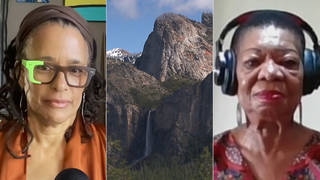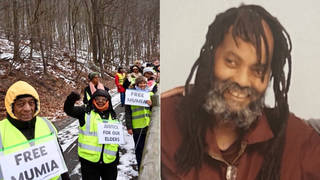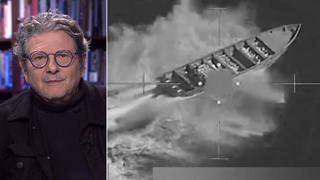
We speak with an attorney and activist for the Coalition of Human Rights and an organizer Southwest Network For Environmental and Economic Justice about the plight of immigrants, industrialization and the dangers of the U.S.-Mexico border. [Includes transcript]
Click here to read to full transcript In recent years, few migrant trails in North America have proved as dangerous as the nearly 300-mile-long stretch of arid borderlands shared by Mexico and Arizona. Untold thousands of woefully unprepared migrants have immersed themselves in this area’s toxic mix of intense heat and sun, seemingly trackless desert and often unscrupulous smugglers. Hundreds have died.
This past May 19 Mexicans and Central Americans were found dead in a tractor-trailer abandoned outside Victoria, Texas–an incident that stands out as one of the deadliest in U.S. immigration history.
Like many other cities along the 2,000 mile-long U.S.-Mexico border, Nogales, Sonora has undergone rapid industrial and population growth during the last 20 years.
Starting in the early 1980s, hundreds of foreign, mostly U.S.-owned factories, known as maquiladoras moved to the border to take advantage of Mexico’s low wages and lax environmental regulations. By the year 2000, more than 4,000 maquiladoras had been established in Mexico with nearly 100 of those in Nogales.
The result: low salaries and high costs. Workers live as squatters in shacks, few have indoor plumbing and some have no water and electricity. Crime and disease are rampant and pollution is widespread along the border.
- Isabel Garcia, attorney and activist with the Coalition for Human Rights (Coalicion por Derechos Humanos)
- Teresa Leal, is an organizer with the Southwest Network For Environmental and Economic Justice, one of the leading organizations of the border protest on Saturday.
TRANSCRIPT
AMY GOODMAN: You’re listening to Democracy Now! broadcasting from Tucson, Arizona. That piece this weekend as we went over the border, over the border from Nogales, Arizona, to Nogales, Mexico in the state of Sonora. We’re joined right now by one of those people who was on this march, the cross border mobilization, Isabel Garcia. She is an attorney and activist with the coalition for human rights, welcome to Democracy Now!.
ISABEL GARCIA: Thank you, Amy.
AMY GOODMAN: We’re also with Teresa Leal who is an organizer with the Southwest Network for Environmental and Economic Justice who took people this weekend on a tour of the machiladoras on the border in Mexico. Welcome.
TERESA LEAL: Gracias (Thank you).
AMY GOODMAN: Let’s continue this discussion of what is happening to immigrants who are attempting to go over the border into the United States. The number… I think most people in this country are not aware and this is just — this area of Arizona, how many again?
ISABEL GARCIA: According to an investigator from the Arizona Republic there had been 205 deaths as of September 30 of 2003. One fiscal year for the border patrol simply between the border of Arizona and Sonora, Mexico, in one year.
AMY GOODMAN: How are people dying?
ISABEL GARCIA: People are dying because they’re being routed and funneled through the deserts, the harsh terrain, most of them are dying because of heat-related reasons. Some people have been killed in accidents where they roll over where they’re being chased by the border patrol. But by and large the dehydration issue as a direct result of the funneling caused by the border patrol strategy of sealing up the major points of entry where people traditionally crossed.
AMY GOODMAN: We watched or looked at this border between Arizona and Mexico, metal corrugated wall that is made from the landing strips that were used during the Persian Gulf War?
ISABEL GARCIA: The landing mats, that’s correct, that were used on the ships of course during the Gulf War. That’s exactly right. Metal. It feels like we’re at war with Mexico if you stand next to that wall.
AMY GOODMAN: When did this wall go up?
ISABEL GARCIA: This wall between Arizona and Sonora started in about 1996 just as our politicians were telling us that NAFTA would be the answer to all of the migration issues is when they started putting up the wall. We knew full well that in fact NAFTA would exacerbate the situation, which it has, and they have continued to build the walls all along the border but here in Arizona, they had plans to build another 255 miles of steel metal wall at a cost of at least $1 million per mile just in terms of the construction not the labor.
AMY GOODMAN: What about the militaritization of the border and have things changed since September 11th?
ISABEL GARCIA: Absolutely. I think people to need to understand that the militarization of the border was in full gear before 9-11. Their intentions of course began in the mid 1990s with Operation Hold The Line, Operation Gate Keeper out of San Diego, Operation Rio Grande in the valley of Texas and of course Operation Safeguard if you can believe that’s the name, Operation Safeguard here in Arizona. And that is a very strategic plan on the part of the border patrol to systematically close one area at a time and funnel people into particular areas, wait until the funneling is successful… In other words, right now there’s 1500 people that arrive in Sonora, just south of the border, every single day in bus loads. They line up and board shuttles to cross into the United States. Their intentions then are to continue the funnel, cause division and chaos within those communities, have deaths and eventually have the local communities throw up their arms and say, okay, militarize this border too, you know give us more agents, we’ll seal it up, then it moves on. We believe that the next point of course of death will be in Texas.
AMY GOODMAN: Isabel Garcia, attorney and activist with the coalition for human rights. We’ll be back with her as well as an organizer with the Southwest Network for Environmental Economic Justice, in a minute. As we turn now to a Tucson-based folk singer who has been performing in this area and around, this is Kathleen Williamson.
(INSTRUMENTAL BREAK)
KATHLEEN WILLIAMSON: For twenty years we shared our home and bed, under heaven’s eyes we were wed. She never learned her own sweet mother’s tongue, for they came to this land when she was young. Kingdoms rise and are inclined to their own brand of law and order. Like menacing landmines the sentencing guidelines sent my love across the border, sent my love south of the border. Now the stars seem more near than where you are, my dear, we won’t let politics decide. In the thunder of my dreams I turn asunder all the schemes when we meet beyond the great divide. Like the moth in flight I follow the bright light . Day and night your candle burns. While in nocturne plays, the swallow flies away. What good is freedom when there’s no return? What good is freedom when there’s no return? (End Instrumental Break)
AMY GOODMAN: Kathleen Williamson here at Access Tucson, the public access TV station in Tucson, that we are broadcasting from. You’re listening to Democracy Now! ,the war and peace report, I’m Amy Goodman. As we continue our discussion of the border we’re joined by Isabel Garcia, who is an attorney and activist with the Coalition for Human Rights and also Teresa Leal, an organizer with the Southwest Network for Environmental and Economic Justice. As immigrants attempt to come over the border, estimates are just in this year alone in Arizona, more than 200 have died. You’re also working on the south of the border, on the machiladora issue, can you talk about the situation for workers there, Teresa?
TERESA LEAL: Well, the situation for workers in the machilas has been an experience that for more than 30 years has been like the laboratory where the globalization process has been tried and different strategies are in place to see how all of the cheap labor market can be controlled under these large economic blocks. And that comes from the industrial or the big corporate agendas. But on the other side which is the grass roots, the working class and the need to survive has produced also a strategy that we have tried, that we have created — also we have tried and tested many things other than unionization, we’ve also developed an industrial revolution a la Mexicana, which is also — the industrial revolution that a lot of folks have to —- are sucked into are not prepared for but the accident… then… that we are just a—- a part of this agenda, this industrialization agenda has forced us — coming from rural areas, indigenous areas and very traditional ways of surviving into immediate hi-tech without any preparation or negotiation and that’s why when NAFTA began to be fast-tracked we immediately knew that we needed to resist this, we needed to surface all of the issues that we had been struggling with as the machiladora came to be. And we call, you know, the maquiladoras just… to make the world a machiladora for these corporations . And so in Nogales it hasn’t been any different, we were a lot less, maybe urban prepared than a lot of areas like Ciudad Juarez and Tijuana, but I think that over the 30 years, for example, our network has created the strategy which is a networking strategy to get little groups and little local experiences tied so that we can create the indicators of development strategy. So that we can follow the bad actors from place to place and share that information.
AMY GOODMAN: Can you talk about what workers face in terms of the toxins, for example, in the environment. You can talk about particular companies or factories.
TERESA LEAL: Well, what workers face is again, just coming out of the darkness, no preparation again. And we’ve had to learn to discern, you know, from hi-tech jargon things that are — that can cause cancer, that can cause tumors, respiratory diseases…
AMY GOODMAN: Like what?
TERESA LEAL: I guess the most endemic is lead, over 70% of the maquilas have lead in some process. Lead …well I’ll just mention one, prestalite makes batteries, the terminals for car batteries and other spark plugs… all of that is a high content of lead in it. Workers, two years ago we had to mobilize and shut down the plant just by just blocking the entrance because workers were getting 50 parts per million in their bloodstream of lead. And the only reason they found out is because they were getting dizzy spells, they were having chronic headaches, they had nervous problems… and they didn’t go to the plant manager because he refused to accept that. They would test them and the testing would be secret. They would not allow them to know the results. Ten parts per million is acceptable and even that is not acceptable.
AMY GOODMAN: Does the EPA play any role here, the Environmental Protection Agency of the United States on the Mexican side of the border?
TERESA LEAL: Lately, yes, a little because the exchange of information, there’s a push to make universal standards available, but that’s still heavily resisted. The EPA only establishes parameters that we can compare to —that as activists we can say, well, if this is not acceptable in the United States, this, like 50 parts per million is incredible! And people would be given a diuretic and sent home to pee for three days. To get that much lead out of people’s bloodstream is incredible, and permanent damage is caused by that. But we do, for example, indirectly we use the standards in order to challenge these corporations that come out of the United States, that have their headquarters in the United States or in other developed countries that should adhere to that. There are voluntary standards that they do— or programs like the isos which are the international systems but they’re purely voluntary so, we again, the way i’m speaking the- you can tell right away that this isn’t something that a worker on the line is really very well versed in. so we require to teach people, you know, about this in simple ways in ways that they can assimilate and take back into their plant, and negotiate these changeovers.
AMY GOODMAN: Isabel Garcia, how are people organizing?
ISABEL GARCIA: Well, here in Tucson, Arizona, southern Arizona, we’ve been fortunate that we’ve been organizing for 30 years. In these 30 years we have created coalition with labor, with environmental groups and with the religious groups. In the 1970’s this didn’t exist, we now have a large community here that is attempting to resist really the national phenomenon- the anti-immigrant fervor of this country is at an all-time high. The ignorance about the contributions of immigrants is at an all-time high. We have a denial of what the reality is in this country and that is that we depend on the immigrant labor force! But for the immigrant labor force, undocumented immigrant labor force, in this country, our economy would be in shambles. In fact certain sectors of the economy would fall apart in less than one day. The other thing that we’re ignorant about is that we have created this particular phenomenon of attraction and repulsion, attracting labor force at times of economic boom and trying to deport people when we have systemic problems so that the American public does not focus on why we’re having an economic downturn. Immigrants are always pulled out as the convenient scapegoat. I think in this country we just need massive education about the issues, about immigration and the border.
AMY GOODMAN: Are maquiladoras leaving, are these factories leaving- either going south, deeper into Mexico and Central and South America or other places entirely? And what does that mean for the people who are working in them?
TERESA LEAL: The maquiladoras are here to stay. The ones that are here, basically I’d say that in the last five years there has been a crisis in the maquiladoras, but that’s due to the lowering of prices and the lack of successes in the market itself, you know, in the buying of goods all over the world as well as in the United States. So, a lot of these markets, because they’re having fewer customers are folding- a lot of them are folding or downsizing. They’re creating more robots to replace the line workers. But also there is —- now with the FTAA which plans to change the entire Latin American continent into a maquiladora— there is talk about it just spreading all over, and that might be, but i don’t think it will be as fast or as complete as it seems because the fuel costs for transportation are still what keeps maquiladoras on the U.S.-Mexico border because cost of fuel were something that has been dealt with before, and that’s the attraction that the U.S.-Mexico border has. So we’ll retain a large majority of these maquiladoras but they are downsizing in many ways. And they are going into the interior of Mexico. Now i don’t know if you realize it, there’s also a lot of unrest, political unrest in Mexico, social unrest, and that tends to spook industrial development. Right now, very few of these maquiladoras can really develop huge expansion projects, but one of them just last week was inaugurated by President Fox, the Sonoran governor, that was the Ford plant in Hermasillo. But- it’s expanding to fit more vehicles, but- right now the Ford plant produces 600 Ford Tracers, which are little compact cars, a day, which are shipped through Nogales and come into Tucson to be distributed all over the country. And yet- they’re now expanding but the expansion is going to be with robots. And apparently that will produce more production and byproducts, but i don’t think that maquilas will go away.
AMY GOODMAN: For people around the country, what do you think is the most important fact, Isabel Garcia, for us to understand about this border where you live?
ISABEL GARCIA: That we are so far away from the seats of power, both Washington D.C. and Mexico City, and yet we feel the impact of course of legislation coming from there, in particular the United States. The border policy I think is a criminal act. I think we will be judged harshly. Most people ignore the situation here at the border, the 205 bodies have been found as you stated, there’s many bodies that have not been found. Border patrol continues to deny the deaths that their agency doesn’t find. In other words if the county sheriffs find a body they refuse to do it. They have caused incredible division as you know, we’ve got vigilantes acting out border policy here, with impunity. We have people dying on a daily basis. And we have immigrants that continue to suffer all of the issues that — immigrants suffer in the interior without being given the benefit of what they have contributed to this country. Our dependence on immigrant — on the immigrant labor force is unbelievable and more and more our country is being — is acting as a gate keeper for the multi-national corporations attempting to create a maquiladoras nation in Mexico and in the countries south of Mexico.
AMY GOODMAN: I want to thank you both very much for being with us, Isabel Garcia with the Coalition for Human Rights and Teresa Leal, organizer with the Southwest Network for Environmental and Economic Justice. Thank you.












Media Options